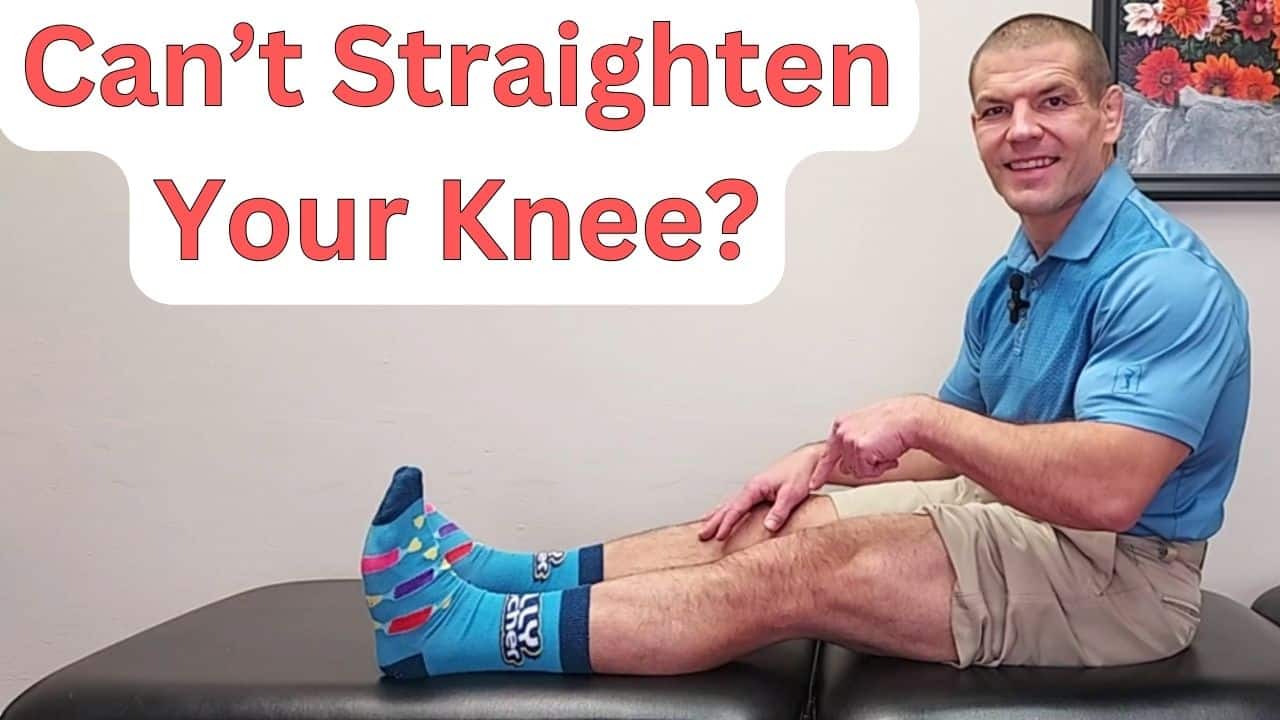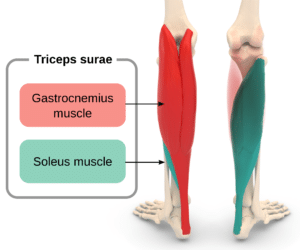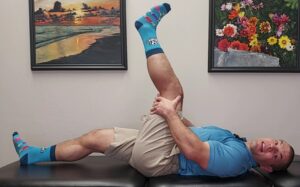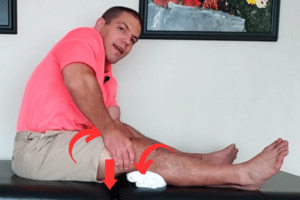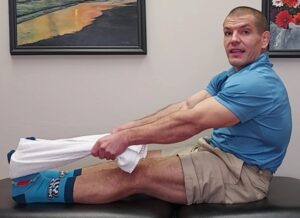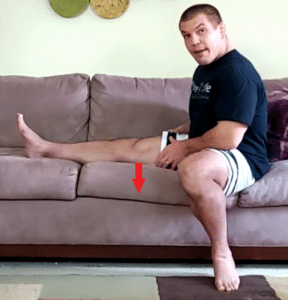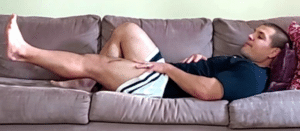Why Can't I Straighten My Knee?
If you can't straighten your knee, you may be worried that you've sustained a serious knee injury.
There are in fact some serious knee problems that can cause you to be unable to straightening your knee. However, there are also some less serious reasons why you may have difficulty straightening your leg.
In this video, I'll unravel some of the most common causes, give you tips to help straighten your knee, and help you understand when it's time to get further help.
Table of Contents
- Is It Serious If I Can't Straighten My Knee?
- Possible Reasons That You Can't Straighten Your Knee
- Why Can't I Straighten My Knee?
- How To Get Your Knee To Straighten
- Joint Mobilization To Strengthen Knee
- Muscle Stretches To Help Straighten Knee
- Quadriceps Strengthening Exercises To Improve Knee Extension
- Straight Leg Raise Exercise
- The Fastest Way To Get Your Knee To Straighten
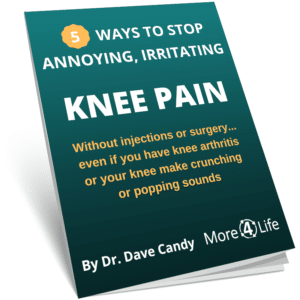
Is It Serious If I Can't Straighten My Knee?
If you've recently sustained a knee injury, these are some signs that there might be serious damage to your knee:
- Your knee has swollen up
- You can't put weight on it
- You feel like it might give out on you when you're walking
If you're experiencing any or all of those symptoms, you should probably get help from a professional.
These symptoms could a meniscus tear or a torn ligament in your knee.
However, if you have a chronically stiff knee, either from knee arthritis or following a surgery (more than 3-6 months ago) that never fully recovered even after finishing your physical therapy, the tips below may be helpful.
Possible Reasons That You Can't Straighten Your Knee
There are several different things that can cause you to be unable to straighten your knee.
In the case of an acute injury, it may be swelling inside the knee capsule, muscle spasms, or meniscus or fat pad that's stuck inside the joint.
Again, those are things you probably don't want to push past, things you probably don't want to treat on your own.
Stiffness of the knee joint capsule can also cause difficulty straightening your leg.
Additionally, muscle stiffness in your calves and hamstrings may make it cause you to be unable to straighten your leg.
Or it could be that your leg straightens if you push it, but you just can't straighten it under the power of your own muscles.
I'll give you tips to help out with all of those problems below.
But how do you know which of the problems it is?
Why Can't I Straighten My Knee?
Most people initially think of hamstring stiffness when they can't straighten their knee.
But the reality is, if you're having difficulty straightening your knee when you're standing up, it's probably not the hamstrings.
...or at least not exclusively the hamstrings.
That's because all of the muscles that prevent knee straightening are two-joint muscles:
- Your hamstrings cross both the knee and the hip
- Your calves, or at least the gastrocnemius part of your calves, crosses the knee and the ankle.
You can do tests to determine why you can't extend your knee fully.
These tests can tell which of the muscles are stiff, or if your knee joint is stiff.
To do the test, lie down on your back and see if you can get your knee all the way flat up against the back of a firm table or floor.
Capsular Stiffness Limiting Knee Extension
Try to press your knee flat or have someone else press it flat. Make sure your toes are pointed downward.
If you can't straighten your knee all the way flat and somebody else can't push it flat when you're lying on your back with your toes pointed, it's probably a joint problem.
That's because your hamstrings are shortened over the hip and your calves are shortened over the ankle. Therefore, neither will limit knee extension.
Quadriceps Strength
If somebody else can press your knee straight in this position, but you can't do it yourself, it's probably a quadriceps muscle strength problem.
That's because your knee has the range of motion to straighten, you just can't straighten your knee under your own muscle power.
Calf Stiffness Limiting Knee Extension
If you can straighten your knee all the way lying on your back, then try pulling your toes up.
If that causes your knee to bend (or bend farther than it was before), that indicates some gastrocnemius (calf) stiffness.
That's because when you stretch the calf across the ankle joint, it causes your knee to bend.
If your knee bends up more when you pull your toes up, that's a calf problem because you've just stretched your calves across the ankle.
Hamstring Stiffness Limiting Knee Extension
Finally, to test your hamstrings, bend your thigh up to a 90 degree angle with your body. Then try to straighten your knee.
A normal hamstring flexibility test would be to get your knee within 10 degrees of fully straight when your hip is flexed to 90 degrees.
If the only time you are unable to straighten your knee is when your hip is bent (such as sitting with your legs straight out in front of you), then it may be the hamstrings that's limiting your knee extension.
However, if your hamstrings are the only reason you can't straighten your knee, you probably won't notice this in everyday life.
How To Get Your Knee To Straighten
Now that we've discussed why you may be unable to straighten your knee, now we'll discuss solutions for each problem.
Joint Mobilization To Strengthen Knee
If you have a joint problem, it's not going to matter how flexible or strong your muscles are because you can't straighten the joint.
To address the joint mobility problem, we need a joint mobility solution.
To understand the solution, you have to understand how the bones work in the knee when you're moving.
As you straighten your knee, the tibia, your lower leg bone, glides forwards, or anteriorly. Relatively the femur glides posteriorly (backwards).
So, we need to improve the mobility of the tibia to glide forwards or the femur to glide backwards.
In most cases, it's much easier to glide the femur backwards.
To do this, we're going to take a towel and put it underneath your knee.
You do need a hard or a firm surface for this. A standard bed that you have at home probably won't work.
You do need to do it either on a treatment, the floor, or with a backing (i.e. a sheet of plywood) behind your knee if you're sitting on a bed.
Now, you'll put the towel under the calf just below the knee.
This blocks the tibia from gliding backwards.
Then you can glide the femur backwards on the tibia as shown below.
You want your forearm to point pretty much straight down.
This causes your to glide backwards and the tibia to glide forward.
Just do little, tiny oscillations (about 1/8 inch). This shouldn't be a big arcing motion of your knee.
Do the oscillations for about 1 minute. Then lie back down and recheck how straight you can get your knee.
Muscle Stretches To Help Straighten Knee
Next, we want to work on muscle stretches to help straighten your knee.
Largely, I think the best calf stretch is standing.
However, in this circumstance, it is beneficial to stretch your calves sitting down because you can also stretch your hamstrings at the same time.
You can also visually see your quadricep muscle.
You can do an active knee extension (a.k.a. "quad set") where you try to contract your thigh muscles and push your knee flat down into the bed.
Then you can pull the toes up with the towel and lean back a little bit as much as the towel allows you to.
That takes at least some of the tension off your hamstrings. If you're sitting up straight like this, that's going to put your hamstring on a lot of stretch.
The more you lean back into it, it takes your hamstrings off stretch a little bit.
Pull your toes up towards you, which stretches the calf across the ankle as well as across the knee.
At the same time, squeeze your quad muscle and try to use your own muscles to press your knee flat into the bed.
Ideally, try to hold this stretch for at least 60 seconds.
If you need to take breaks, then split it up. Do two sets of 30 seconds or four sets of 15 seconds or three sets of 20 seconds as long as you're getting at least minute total stretch time.
Quadriceps Strengthening Exercises To Improve Knee Extension
After you've improved your knee joint mobility and muscle flexibility, now it's time to get your quadriceps muscles activated.
One of the best ways to do that is doing the quad set that I mentioned before.
There are some advantages to doing it sitting:
- You can see the visual feedback of your thigh muscle changing contour.
- You should also see your kneecap move up towards you when you contract your quadricep muscle.
This is particularly important after a knee surgery when your quadriceps may be inhibited by post-surgical swelling.
(Note: If you have had a recent knee surgery, check with your surgeon and therapist before trying these tips.)
However, when you're in this sitting position, you may be unable to straighten your knee fully if you have some stiffness in your hamstrings.
You can also do the quad set lying down which puts your hamstrings on slack. Focus on straightening the knee down all the way using your own muscle power.
Straight Leg Raise Exercise
Once you can fully extend your knee doing a quad set, you can move on to another exercise known as the straight leg raise.
It's aptly called that because you try to straighten your leg and then raise it up in the air.
This is a very common post-surgical knee exercise.
There are a couple key points to keep in mind when doing a straight leg raise:
- Do the quad set, get your knee as straight as you possibly can.
- Then, think of lifting your heel off the table before your knee. You want to actually try to hyperextend your knee here. That may or may not happen, but think about lifting the heel up before your knee.
- Keep your knee locked out in full extension as you raise the leg up.
- Hold about 10 seconds at the top position.
- Slowly lower your leg back down, again keeping your knee completely straight the entire time.
- Repeat this sequence working up to 10 repetitions with a 10-second hold each.
Once you've done this, it's time to move up to standing exercises.
Ideally, standing weight-bearing exercises are the best and most functional way to strengthen your knee.
We don't function much in a sitting down or lying down position. We uses our knees most in standing.
I'm not going to cover those exercises in this post, but I'll link to some of our other posts that cover weightbearing knee strengthening exercises at the bottom of this post.
However, the fastest way to get your knee to straighten is to see an orthopedic manual physical therapist.
Our fellowship-trained orthopedic manual physical therapy specialists can help you figure out why you can't straighten your knee plus do hands-on treatments to help you improve your knee range of motion while also decreasing knee pain.
If you live in the St. Louis area and need help to straighten your knee, tap the button below to request an appointment with one of our orthopedic manual physical therapy specialists.
Like this post? Here are some others you may enjoy:
Strengthen Knee With Exercises At Home
Best Leg Strengthening Exercise For Seniors
My Knee Hurts When Doing Lunges! 7 Tips To Stop Knee Pain From Lunges

